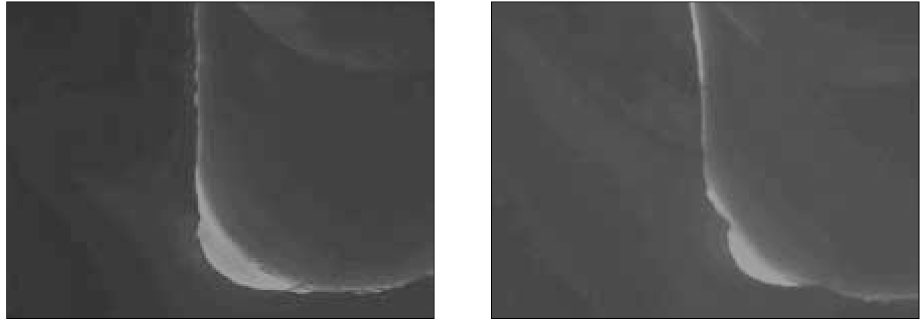J Korean Acad Conserv Dent.
2007 Jan;32(1):9-18. 10.5395/JKACD.2007.32.1.009.
The effect of adhesive thickness on microtensile bond strength to the cavity wall
- Affiliations
-
- 1Department of Conservative Dentistry, College of Dentistry, Pusan National University, Busan, Korea. jeongkil@pusan.ac.kr
- KMID: 1986926
- DOI: http://doi.org/10.5395/JKACD.2007.32.1.009
Abstract
- The purposes of this study were to examine the variability of adhesive thickness on the different site of the cavity wall when used total-etch system without filler and simplified self-etch system with filler and to evaluate the relationship between variable adhesive thickness and microtensile bond strength to the cavity wall. A class I cavity in six human molars was prepared to expose all dentinal walls. Three teeth were bonded with a filled adhesive, Clearfil(TM) SE bond and the other three teeth were bonded with unfilled adhesives, Scotchbond(TM) Multi Purpose. Morphology and thickness of adhesive layer were examined using fluorescence microscope. Bonding agent thickness was measured at three points along the axial cavity wall, edge of cavity margin (rim), halfway down each cavity wall (hlf), internal angle of the cavity (ang). After reproducing the adhesive thickness at rim, hlf and ang, micro-tensile bond strength were evaluated. For both bonding agents, adhesive thickness of ang was significantly thicker than that of rim and hlf (P < 0.05). As reproduced the adhesive thickness, microtensile bond strength was increased as adhesive thickness was increased in two bonding agents. Adhesive thickness of internal angle of the cavity was significantly thicker than that of the cavity margin and the halfway cavity wall for both bonding agents. Microtensile bond strength of the thick adhesive layer at the internal angle of the cavity was higher than that of the thin adhesive layer at the cavity margin and the halfway cavity in the two bonding systems.
Keyword
Figure
Cited by 1 articles
-
The effect of Er,Cr:YSGG irradiation on microtensile bond strength of composite resin restoration
Jeong-Hye Son, Hyeon-Cheol Kim, Bock Hur, Jeong-Kil Park
J Korean Acad Conserv Dent. 2010;35(2):134-142. doi: 10.5395/JKACD.2010.35.2.134.
Reference
-
1. Nakabayashi N, Nakamura M, Yasuda N. Hybrid layer as a dentin bonding mechanism. J Esthet Dent. 1991. 3(4):133–138.2. Frankenberger R, Kramer N, Petschelt A. Technique sensitivity of dentin bonding: effect of application mistakes on bond strength and marginal adaptation. Oper Dent. 2000. 25(4):324–330.3. Kaaden C, Powers JM, Friedl KH, Schmalz G. Bond strength of self-etching adhesives to dental hard tissues. Clin Oral Investig. 2002. 6(3):155–160.
Article4. Perdigão J, Lopes M. Dentin bonding-questions for the new millennium. J Adhes Dent. 1999. 1(3):191–209.5. Grossman ES, Setzer S. Bonding Agents: Adhesive layer thickness and retention to cavity surfaces with time. SADJ. 2001. 56(6):266–272.6. Peter A, Paul SJ, Luthy H, Scharer P. Film thickness of various dentine bonding agents. J Oral Rehabil. 1997. 24(8):568–573.
Article7. Van Meerbeek B, Perdigao J, Lambrechts P, Vanherle G. The clinical performance of adhesives. J Dent. 1998. 26(1):1–20.
Article8. Perdigão J, Lambrechts P, Meerbeek BV, Braem M, Yildiz E, Yucel T, Vanherle G. The interaction of adhesive systems with human dentin. Am J Dent. 1996. 9(4):167–173.9. Retief DH, Wendt SL, Bradley EL. The effect of adhesive thickness on the shear bond strength of Scotchbond 2/Silux to dentin. Am J Dent. 1989. 2(6):341–344.10. Zheng L, Pereira PNR, Nakajima M, Sano H, Tagami J. Relationship between adhesive thickness and microtensile bond strength. Oper Dent. 2001. 26(1):97–104.11. Gallo JR, Comeaux R, Haines B, Xu X, Burgess JO. Shear bond strength of four filled dentin bonding systems. Oper Dent. 2001. 26(1):44–47.12. Fortin D, Swift EJ, Denehy GE, Reinhardt JW. Bond strength and microleakage of current dentin adhesives. Dent Mater. 1994. 10(4):253–258.
Article13. Yoshiyama M, Carvalho R, Sano H, Horner J, Brewer PD, Pashley DH. Interfacial morphology and strength of bonds made to superficial versus deep dentine. Am J Dent. 1995. 8(6):297–302.14. Eick JD, Robinson SJ, Chappell RP, Cobb CM, Spencer P. The dentinal surface: Its influence on dentinal adhesion. PartIII. Quintessence Int. 1993. 24(8):571–582.15. Staninec M, Marshall GW, Kawakami M, Low A. Bond strength, interfacial characterization and fracture surface anylysis for a new stress-breaking bonding agent. J Prosthet Dent. 1995. 74(5):469–475.
Article16. Opdam NJ, Roeters FJM, Verdonschot EH. Adaptation and radiographic evaluation of four adhesive systems. J Dent. 1997. 25(5):391–397.
Article17. Hilton TJ, Schwartz RS. The effect of air thinning on dentin adhesive bond strength. Oper Dent. 2001. 20(4):133–137.18. Perdigao J, Lopes M, Gomes G. Ultramorphology of the hybrid layer - a TEM study of non-decalcified interfaces. J Dent Res. 2000. 79:336.19. Erickson RL. Surface interactions of dentin adhesive materials. Oper Dent. 1992. Suppl 5. 81–94.20. Van Meerbeek B, Inokoshi S, Braem M, Lambrechts P, Vanherle G. Morphological aspects of the resin-dentin interdiffusion zone with different dentin adhesive systems. J Dent Res. 1992. 71(8):1530–1540.
Article21. Staninec M, Kawakami M. Adhesion and microleakage tests of a new dentin bonding system. Dent Mater. 1993. 9(3):204–208.
Article22. Fanning DE, Wakefield CW, Robbins JW, Bagley AL. Effect of a filled adhesive on bond strength of three dentinal bonding agents. Gen Dent. 1995. 43(3):256–262.23. Marshall GW Jr, Marshall SJ, Kinney JH, Balooch M. The dentin substrate: structure and properites related to bonding. J Dent. 1997. 25(6):441–458.
- Full Text Links
- Actions
-
Cited
- CITED
-
- Close
- Share
- Similar articles
-
- The effect of hybrid layer thickness on microtensile bond strength of three-step and self-etching dentin adhesive systems
- Effect of moisture and drying time on the bond strength of the one-step self-etching adhesive system
- The effect of multiple application on microtensile bond strength of all-in-one dentin adhesive systems
- Influence of application methods of one-step self-etching adhesives on microtensile bond strength
- Effect of a desensitizer on microtensile bond strength of different adhesives


